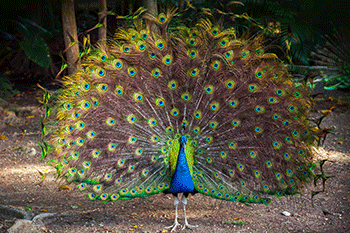Author: Tyler Berrigan / Source: Science News for Students

Nature’s colors can delight the eye. But these dazzling displays can also have many practical uses.
For example, some animals hide themselves from predators by changing color to blend into their surroundings. This is known as camouflage. Researchers from Europe have taken inspiration from this to develop a new material. It changes color when exposed to moisture. And the researchers can decide beforehand which colors or patterns that moisture will reveal.It all has to do with the new material’s structure.
Consider a peacock’s feathers. They’re a fairly boring brown. Yet your eye doesn’t perceive them that way. The features appear vibrant and multi-colored due to what’s known as structural color. Microscopic features on a plume’s surface can reflect or scatter light in some special way. This alters the material’s apparent color.

Waves of certain frequencies of light — colors — can sometimes interfere with, or block, each other. The result? The color seen by the observer is different from the object’s true hue. Besides peacock feathers, other examples of structural color include fish scales and certain butterfly wings.
Monali Moirangthem and Albertus Schenning are material scientists. They work in the Netherlands at the Eindhoven University of Technology.
These researchers specialize in creating “smart” materials. These are ones that have been designed to exhibit unusual properties based on the conditions of their environment. (Such conditions include temperature, pressure, moisture level or the light shining on it.)The researchers were particularly intrigued by beetles that seem to change color in response to differences in humidity. (Humidity is how much moisture is in the air.) This inspired their new artificial material with similar color-changing traits.
While other scientists have achieved this, “They were only able to change between two colors,” Schenning explains. His team didn’t want to limit its color palette to just two hues. They wanted moisture to be able to change their material from one color to any or all others.
And on January 31 they described their success in ACS Applied Materials and Interfaces.
Ink’s color changes with its depth
First, the team produced a solid blue polymer film. A polymer is a material made up of long molecular chains. This special film swells when it makes contact with water.
The researchers then used an inkjet printer to print images onto this polymer film. Their “ink” was a chemical — calcium nitrate — dissolved into water. Altering the number of layers of this ink printed onto the film would change its apparent color as soon as it made contact with water.
One layer of calcium nitrate appears orange. Two layers: green. Three layers look blue. So, to make a certain color show up when the film gets wet, they simply adjust how many layers of ink are printed on it.
Mark MacLachlan is a chemist who focuses on the structure of materials on a molecular scale. He works in Canada at the University of British Columbia, in Vancouver. “When the polymer film comes in contact with water and swells,” he notes, “it changes the dimensions of the pre-printed surface structures.” This, he explains, changes the wavelength — or color — of light that reflects back to the eye of the observer.

The post Moisture unmasks camouflaged message appeared first on FeedBox.